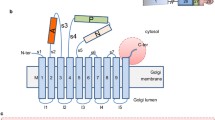Abstract
Hailey–Hailey disease (HHD) is caused by heterozygous mutations in the ATP2C1 gene, encoding the secretory pathway Ca2+ ATPase1 (SPCA1). SPCA1 and sarco/endoplasmic reticulum Ca2+ ATPase2 (SERCA2) encoded by ATP2A2 are two essential calcium pumps needed for Ca2+ homeostasis maintenance in keratinocytes. ATP2A2 mutations cause another hereditary skin disorder, Darier’s disease (DD). Previously, the compensatory expression of SPCA1 for SERCA2 insufficiency in DD was demonstrated, but it is not known whether a similar compensatory mechanism exists in HHD. Additionally, little is known about the role of p63 and interferon regulatory factor 6 (IRF6), two important regulatory factors involved in keratinocyte proliferation and differentiation, in HHD. Here, we used the skin biopsy samples from patients with HHD and human primary keratinocytes transfected with ATP2C1 siRNA to search for potential pathogenic mechanisms in HHD. We observed normal SERCA2 levels, but reduced p63, and increased IRF6 levels in HHD epidermal tissues and SPCA1-deficient keratinocytes. This suggests that there is no compensatory mechanism by SERCA2 for the SPCA1 deficiency in HHD. Moreover, the abnormal expression of p63 and IRF6 appears to be related to SPCA1 haploinsufficiency, with down-regulation of p63 probably resulting from IRF6 overexpression in HHD. We speculate that a novel pathogenic mechanism involving SPCA1, p63, and IRF6 may play a role in the skin lesions occurring in HHD.




Similar content being viewed by others
References
Bailey CM, Abbott DE, Margaryan NV et al (2008) Interferon regulatory factor 6 promotes cell cycle arrest and is regulated by the proteasome in a cell cycle-dependent manner. Mol Cell Biol 28(7):2235–2243
Carroll DK, Brugge JS, Attardi LD (2007) P63, cell adhesion and survival. Cell Cycle 6(3):255–261
Chia-Ling Tu, Chang Wenhan, Bikle Daniel D (2007) The Role of the calcium sensing receptor in regulating intracellular calcium handling in human epidermal keratinocytes. J Invest Dermatol 127(5):1074–1083
Cialfi S, Oliviero C, Ceccarelli S et al (2010) Complex multipathways alterations and oxidative stress are associated with Hailey–Hailey disease. Br J Dermatol 162(3):518–526
Zhang Dingwei, Li Xiaoli, Xiao Shengxiang et al (2012) Detection and comparison of two types of ATP2C1 gene mutations in Chinese patients with Hailey–Hailey disease. Arch Dermatol Res 304(2):163–170
Fairclough RJ, Lonie L, van Baelen K et al (2004) Hailey–Hailey disease: identification of novel mutations in ATP2C1 and effect of missense mutation A528P on protein expression levels. J Invest Dermatol 123(1):67–71
Foggia L, Aronchik I, Aberg K et al (2006) Activity of the hSPCA1 Golgi Ca2+ pump is essential for Ca2+-mediated Ca2+ response and cell viability in Darier disease. J Cell Sci 119(Pt4):671–679
Hu Z, Bonifas JM, Beech J et al (2000) Mutations in ATP2C1, encoding a calcium pump, cause Hailey–Hailey disease. Nat Genet 24(1):61–65
Manca S, Magrelli A, Cialfi S et al (2011) Oxidative stress activation of miR-125b is part of the molecular switch for Hailey–Hailey disease manifestation. Exp Dermatol 20(11):932–937
Missiaen L, Dode L, Vanoevelen J et al (2007) Review calcium in the Golgi apparatus. Cell Calcium 41(5):405–416
Moretti F, Marinari B, Lo Iacono N et al (2010) A regulatory feedback loop involving p63 and IRF6 links the pathogenesis of 2 genetically different human ectodermal dysplasias. J Clin Invest 120(5):1570–1577
Porgpermdee S, Yu XB, Takagi A et al (2005) Expression of SPCA1 (Hailey–Hailey disease gene product) in acantholytic dermatoses. J Dermatol Sci 40(2):137–140
Sabel JL, d’Alençon C, O’Brien EK et al (2009) Maternal interferon regulatory factor 6 is required for the differentiation of primarysuperficial epithelia in Danio and Xenopus embryos. Dev Biol 325(1):249–262
Li Xiaoli, Zhang Dingwei, Xiao Shengxiang et al (2012) Four novel mutations of the ATP2C1 gene in Chinese patients are associated with familial benign chronic pemphigus. Clin Exp Dermatol 37(7):797–799
Yang A, Kaghad M, Caput D et al (2002) On the shoulders of giants: p63, p73 and the rise of p53. Trends Genet 18(2):90–95
Acknowledgments
We would like to thank the patients for participating in the study. This work was supported by the Natural Science Foundation of China (No. 30901297), the Doctoral Fund of Youth Scholars of Ministry of Education of China (20090201120074), and Xi’an Jiaotong University.
Conflict of interest
All of the authors declare here that we have no conflict of interest about this article.
Author information
Authors and Affiliations
Corresponding author
Rights and permissions
About this article
Cite this article
Zhang, D., Li, X., Wang, Z. et al. Hailey–Hailey disease: investigation of a possible compensatory SERCA2 up-regulation and analysis of SPCA1, p63, and IRF6 expression. Arch Dermatol Res 307, 143–149 (2015). https://doi.org/10.1007/s00403-014-1506-2
Received:
Revised:
Accepted:
Published:
Issue Date:
DOI: https://doi.org/10.1007/s00403-014-1506-2




